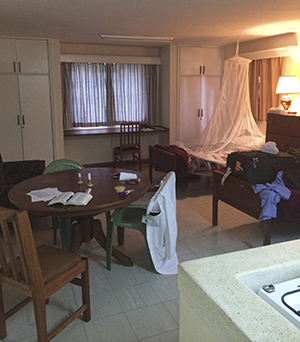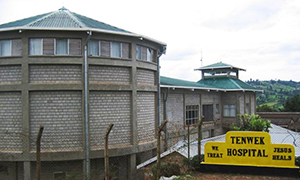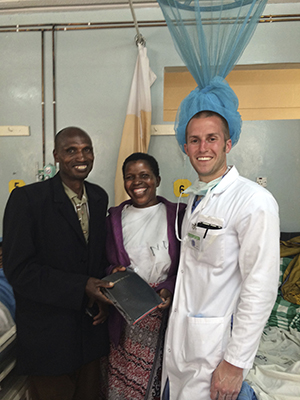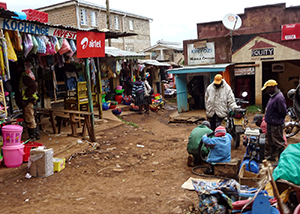AANS Neurosurgeon : International
Volume 24, Number 2, 2015
Neurosurgical Travels in Kenya
William R. Copeland III, MDEditor’s Note: In our international section, we typically take the opportunity to talk with surgeons from other countries about the state of neurosurgery where they are. However, how do you ask a neurosurgeon the state of their country where there are none? In this month’s International section, we take the opportunity to have William Copeland, MD, a resident who is facing the start of his career, discuss his experience with international neurosurgery in Africa. He has made the extraordinary choice to start his career for two years in Kenya prior to starting his career in the U.S. Here he informs us of this remarkable place, as well as how to become involved with international initiatives.
I recently took a month-long trip that has changed the trajectory of my career. I have long been interested in international health care, so when I began planning for my elective time during my fifth year of residency, I decided to investigate what opportunities were available to spend time working in a developing country. During my initial search, I was somewhat discouraged at what I perceived as a lack of opportunities, but with persistence on Google and some asking around, I discovered there were several potential options. One that I decided to further investigate was at Tenwek Hospital in Kenya, in part because my institution had an established relationship with Tenwek, regularly sending residents from other departments to visit. I found one minor problem — there was no neurosurgeon at the hospital. There was, however, a neurosurgeon from the States, who, retired from private practice, had been visiting Tenwek several times a year for the past several years, and he was planning a trip at the time I was looking to make mine. So my choice was made.
 Living arrangements for the month-long trip.
Living arrangements for the month-long trip.
Living and Working Conditions in Tenwek
Tenwek is located in Bomet, a town of approximately 110,000 people, roughly 150 miles west of Nairobi. That 150 miles takes four hours to drive, however, and was described by several of the long-term American physicians at Tenwek as the most dangerous part of their job. So after that drive and the preceding 16 hours of flight time to get to Nairobi, I arrived to Tenwek exhausted. I didn’t quite know what to expect on arrival, but I was warmly received and welcomed with a clinic full of patients.
The living arrangements were surprisingly nice. I stayed alone in a one-bedroom space with a twin bed. Every night, I slept under a mosquito net — something I’d never done before. There was a private bathroom and shower with running hot water and a kitchen with a stove where I could make breakfast, which usually consisted of scrambled eggs, toast and fruit. The water was not safe to use unless filtered, but this was easily obtainable for drinking, brushing teeth, etc. WiFi Internet was available. Lunch and dinner were provided every day in a common dining hall. Laundry services were available as needed for a small cost. I never once felt unsafe while at Tenwek.
 Tenwek Hospital, Bomet, Kenya.
Tenwek Hospital, Bomet, Kenya.
Tenwek Hospital was established in 1935 as an aide station staffed by missionary nurses. Over the years, it grew into an outpatient clinic and, in 1959, recruited its first physician. Today, it is one of the largest mission hospitals in Kenya, with not only a hospital, but also a nursing school, a community health and development program, and a children’s home. The hospital itself has six operating rooms and more than 300 beds — not like we think of with private rooms and baths, but rather large wards with beds lined up along the walls. A variety of ongoing services are provided at Tenwek, including adult and pediatric primary care, OB/GYN, general and orthopedic surgery, ophthalmology and dentistry. With no neurosurgeon present at the hospital, the general surgeons have learned to handle many cases, including epidural and subdural hematoma evacuations, shunting for hydrocephalus, and closure of neural tube defects. Imaging modalities available at the hospital include X-ray, ultrasound and CT scanning. Basic lab and microbiology studies are performed. If pathology is needed, specimens are sent to Nairobi.
The native residents and OR staff I worked with were smart, hard-working and skilled in their positions. During my time at Tenwek, one of the Kenyan surgery residents was assigned to our team. He would round in the hospital, see patients in clinic and operate with us. He was more than capable, and I valued the time I worked with him.
Time in the Clinic
Our clinic days were Tuesdays and Thursdays, which typically consisted of seeing 30 to 40 patients per day. The hospital staff had been anxious for our arrival and had already set up a few days’ worth of patients for us to see. All hospital staff and many patients spoke English though the official language of Kenya is Swahili. Translators were readily available when needed. To my surprise, there was a recently installed electronic medical record. We saw a variety of pathology, much of which was degenerative and infectious spinal disorders. Evaluating these patients required a skill set I had never learned. When someone was suspected of having spinal cord or nerve root compression, no access to MRI left us having to obtain myelograms. And there was no radiologist to read them. Rather, between seeing patients, one of us would run to X-ray where we squeezed in a half-dozen myelograms a day. Those patients with pseudoclaudication would have a central blocking of the dye, while those with a lumbar radiculopathy would have blunting of the exiting nerve root. If either of these were found, patients would be offered surgery or an epidural steroid injection — another procedure that I learned for the first time. We even performed C1/2 punctures to evaluate for cervical stenosis. And, if needed, we could perform CT myelograms though these were often prohibitively expensive for patients and as I discovered, rarely truly necessary. For those patients with spinal disorders that were managed non-operatively, there was an excellent Kenyan physical therapist on-site to provide education and exercises.
 William Copeland III, MD, is pictured with a happy patient and her husband. She had presented with a progressive myelopathy and was found on CT myelogram to have a meningioma that Dr. Copeland resected. Her smile reflects how thrilled she was to be able to stand after surgery.
William Copeland III, MD, is pictured with a happy patient and her husband. She had presented with a progressive myelopathy and was found on CT myelogram to have a meningioma that Dr. Copeland resected. Her smile reflects how thrilled she was to be able to stand after surgery.
Time in the OR
We operated on Mondays, Wednesdays and Fridays. The first case we did was a craniotomy and anterior clinoidectomy for a young boy with visual loss due to fibrous dysplasia. From scrubbing to closure, I found things to be drastically different than I was used to. At the scrub sink, there was a tub filled with chlorhexidine and scrub brushes. After scrubbing, the brushes were placed in an adjacent tub and eventually recycled in a fresh tub of chlorhexidine to be used again and again until they were basically falling apart. Gowns and drapes were linen and also reused. There were no marking pens; incisions were marked out by scratching the skin with the backside of a 10-blade. There were no Raney clips. Monopolar and bipolar cautery were reused and often still too wet from the wash to function appropriately. There was no craniotome so I got my workout everyday using the Hudson brace and Gigli saw for craniotomies. Bone flaps were sutured in placed. Sutures were instrument-tied during closure to maximize the amount of stitches thrown with each suture; staples weren’t available for closure. Even lumbar spine operations were made more interesting, as my patients were awake during surgery, having received regional anesthesia instead of general.
Post-operative care was different. There were no intensivists and only a limited number of ventilators. However, despite all these differences, many of which were frustrating at times, I found that so much of what I thought I couldn’t function without was really only a luxury, not a requirement to do my job. A sampling of cases we performed over the month included lumbar decompressions, thoracolumbar instrumented fusions (one of which included a vertebral column resection with iliac crest grafting due to Pott’s disease), an anterior cervical discectomy and fusion using iliac crest grafting and no plate, an olfactory groove meningioma, a frontal sinus mucocele, subdural and epidural hematomas, a thoracic meningioma, ventriculoperitoneal shunts, an occipital encephalocele, myelomeningoceles, etc.
A Change in Career Plans
 A scene from Bomet, Kenya.
A scene from Bomet, Kenya.
My primary clinical interest is in skull base and cerebrovascular surgery, and in fact, I had begun to interview for fellowship training after residency. However, my wife and I and our four kids have instead decided to apply for Samaritan’s Purse Post-Residency Program, which assigns graduating residents to hospitals in developing countries for a two-year commitment. My desire for that time is to provide care to people who otherwise would not have access to a neurosurgeon and to teach general surgeons in training how to perform basic neurosurgery.
Several people have asked me why I have made this choice, forfeiting potential earnings and the comforts of life here. At present, I cannot turn my eye to the needs I’ve seen overseas; this compels me more than a paycheck. I am so thankful for those who have selflessly trained me, and I recognize there are opportunities to do good in the U.S., opportunities that I will continue to explore in the future. There is without question many challenges to providing health care in a developing country, especially neurosurgery. I have no doubt, however, that it can be done and be done well.
If you are interested in serving at a place like Tenwek, there are many options available. My trip was arranged through Samaritan’s Purse, and they were great, handling all the details of the trip. Other agencies, such as FIENS, Madaktari and CURE International, are helpful resources. If you have questions about my travels or are interested in hearing more, please contact me at copeland.william@mayo.edu.
 William R. Copeland III, MD, is a neurosurgical resident at Mayo Clinic, Rochester, Minn. The author reported no conflicts for disclosure.
William R. Copeland III, MD, is a neurosurgical resident at Mayo Clinic, Rochester, Minn. The author reported no conflicts for disclosure.

